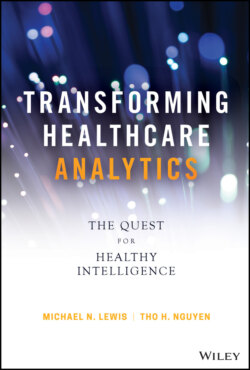Читать книгу Transforming Healthcare Analytics - Michael N. Lewis - Страница 19
MEDICAL PROCEDURES
ОглавлениеMany medical procedures have also advanced to be more effective and efficient. Take, for instance, cataract surgery, which can now be an outpatient procedure where patients can be admitted and released on the same day. Knee surgery patients can go home within a day compared to the past, where patients would have to stay for days in the hospital to recover. Inserting stents for heart patients can be done in hours and patients can also go home within a day to rest and recover in the comfort of their own homes. But no one wants to be in pain during any of these procedures. Anesthesia has been an area undergoing continued improvements. Decades ago, either you had no anesthesia or had to be completely under. Looking back a few decades, patients were worried about the harmful effects of anesthesia. Clinicians used gas that would knock the patient out completely and that would leave them feeling dazed and groggy for hours or even days. Obviously, no patient wants to feel any pain when having surgery. Thankfully, medical procedures such as local anesthetics for simple procedures are more prevalent today and administering anesthetics is also safer. Today, there are options. Anesthesia can be administered locally, meaning only the operating area is numbed. Doctors use injections to numb an area and the patient can be more at ease with the ability to feel other parts of their body. Other times, anesthesia is given to patients who need to be completely asleep.
Thanks to medical research and innovation, heart surgery and stroke victims have shorter operating times with smaller incisions and sharpened techniques. The progress in this medical field has saved many lives, as well as allowed patients to get back on their feet much faster compared to a decade ago. As this book is being written, a friend had just experienced a minor stroke that progressed to a massive stroke within hours after being admitted to the ER. Stroke happens when a blood vessel feeding the brain gets clotted or bursts. He felt numbness on the right side of his body and had collapsed at home while trying to get back into bed. In the ER, the doctors operated on him with two small incisions to unblock the blood flow to his brain. Within hours he was awake and was able to go home within a day. After two days he was on his feet and back to work. It is truly a testament to how far medical procedures have progressed. Researchers are still investigating ways to make things better and more efficient in this field since stroke is the third leading cause of death in the United States.
Of all the ways healthcare has evolved over the years, health technology, medical research, and medical procedures have made the biggest impact. Patients, medical professionals, and healthcare organizations all benefit from these advancements. In addition, these three areas will change and advance even more and make healthcare better for all.
The topic of healthcare has gained a lot of attention in the United States and around the world. Discussions in healthcare can be highly controversial, debatable, and personal. On the other hand, these healthy conversations can be very engaging, uplifting, and impactful. Consumers and healthcare organizations are taking notice of this matter and have begun to acknowledge how healthcare affects everyone on a global scale. The healthcare industry is fascinating for its growth, demand, and influences. In examining the healthcare industry more closely, let's start with its market size and consistent growth.
